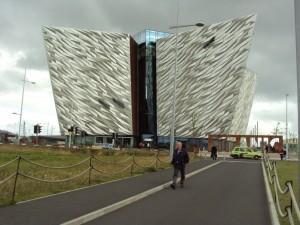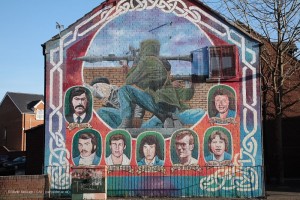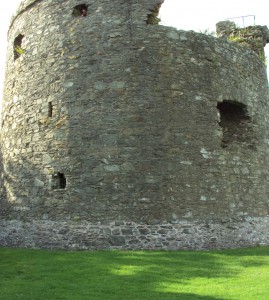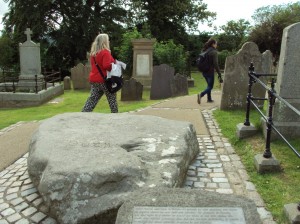Belfast day trip
Belfast Day Trip: No one seemed to worry about the gathering grey rainy cloud which Dublin is known for. I thought I would be alone at the Suffolk Street Tourism Office. I was surprised by the number of tourists who were daring the cold morning weather for the Belfast day trip. Molly Malone, the dear statue of an immortalised hard working Dublin woman was surrounded by people who were taking photographs and hugging her. I could hear a young woman hugging and whispering “my fair feminist lady I love you” into Molly’s ear. I also heard someone speak in Spanish to Molly saying “mama muy Buena”—good mother. There were German tourists overjoyed at finding Molly saying “ my fair lady, sind Sie hier”- my fair lady, you are here. I had reckoned that the tourist might have been searching for Molly who had been moved from her well-visited College Green-Grafton street site to nearby Suffolk-Andrew street Tourist Office entrance. As I looked, being surprised by the admiration of Dublin and Molly by the people around me, I heard a friendly voice urging us to enter our coaches which must leave for the day’s tour at 8.00am sharp. My coach, an 18-seater bus offered us all plenty of room and we were all comfortably seated. A sense of expectation was on every passenger’s face. There were various sizes of maps of South and North Ireland, note books and cameras ready to explore or take in any attractive scene encountered.
At 7.58 am a tall bearded man came onto the bus, smiled and waved to everyone, checked the security measures at the back, walked back to the front seat, cleared his voice and welcomed us on our Irish day tours Belfast day trip. He introduced himself as Shane, our tour guide and chauffeur. He took us briefly through the tour routes, to begin here at the Tourism Office in Suffolk street, then through O’Connell street, pass close to Dublin Airport, a rest in Banbridge, and then on to Belfast; on from there to St Patrick’s grave in Downpatrick, to Dundrum Castle and to the Spelga dam at the foot of the Mourne Mountains. And then, there was an interruption by a young boy Pedro (not his real name) who raised his voice singing Olè, Olè , Olè, Olè, Olè, Olè Belfast, Olè, Olè Titanic. He was not alone, he got many fans amongst us.There was laughter, and as it died down Shane explained the health and safety guidelines – not to eat hot or spicy food on the tour bus so as to avoid travel sickness. He explained the routes to be taken, the stops and rest and time to be spent at each destination. He suggested we introduce ourselves to each other which was welcomed, discovering that we were multinational, or as someone named it “a united nations of a trip”. Yes, everyone on the trip was somehow amazed by the gathering of people from diverse cultures, languages and beliefs. We were from Spain, Switzerland, Israel, Brazil, Ireland, Portugal, Italy, France, Lebanon, Martinique and Singapore. The introduction changed the atmosphere around us; it enabled us to exchange greetings and talk more freely; form friendship that lasted throughout our trip to the North, and maybe beyond.
As our Belfast day trip set off, we left behind the vivid Molly Molone statue; driving past Trinity College onto West Moreland street and crossing the River Liffey, we entered the boulevard of Dublin – O’ Connell Street, which was formerly Sackville street but renamed O’Connell Street to honour one of the heroes of Irish independence. On the Liffey bridge our guide directed our attention to an imposing black statue of Daniel O’Connell. Listening to Shane, one could perceive from his tone the high sacredness and political status of O’Connell Street and its imposing statues of Irish heroes and Georgian buildings. O’Connell Street, I was told, possesses more statues than any other street in Ireland; and its GPO – a key historical building – touched the hearts of most Irish. It was the meeting point for the “Easter Rising” of 1916.
Shane kept his promise of good updates and entertainment and took us through Ireland’s history, from the time of the Vikings and the Battle of Clontarf, to the story of Oliver Crowell and Drogheda massacre; and the origin of the name Ireland /Eire. He drew our attention to scenic views of hills, valleys and vegetation of the River Boyne, its valley and the battle associated with it. Most tourists liked Irish traditional music being played and we learned who the artists were from our guide and the messages being passed through the music sung in Gaelic.Our guide made sure no-one was left behind at our first stop and rest at 9.30 am in Banbridge. Excitement was in the air as we approached Belfast. He wasted no time in announcing the arrival and directing our attention to every nook and cranny. Nor could most of us stop taking photos. I had thought I would be the most excited going on the Belfast day trip since I had not been there before; but it was not me but Pedro who translated the Guide’s every sentence into Spanish for his parents. His parents called him “nuestro traductor”- our translator. It was Pedro, who seeing the Belfast shipyard, exclaimed bienvenido a titanic, bienvenido a titanic—- welcome to Titanic. As we negotiate our way around the shipyard, there was great expression of excitements in various languages; and flashes of light from cameras here and there. Everyone wanted to get out of the bus.
The shipyard building is a great architectural landmark, somehow a glittering- glassy cruise ship like- building. It was the highlight of the tour. We had plenty of time for to wander around the yard and harbour. The yard used to be the largest ship building yard in the world. Apart from decent restaurant and coffee shops one could visit the shipyard museum holding images of SS Venetian which was the first steamer built by Harland and Wolff in 1860, and the Bibby Steamerline built in 1897. There is a Nomadic ship final resting place close to the shipyard. Leaving the Shipyard, our guide offered us an add-on by taking us to Samson and Goliath gantry cranes which are a Belfast landmark.
We then explored Belfast inner city, visiting the Republican museum and the Cupar Way which is the border line between east and west Belfast. The street bears graffiti of visitors calling for peaceful co-existence not only in Belfast but around the world. West Belfast is distinct with its social activism as seen from the writings and drawings on its street walls. The Shankhill area presents a different picture, one feels part of Britain as the British flags and posters adorn the area and its buildings. Remarkably, both Cupar Way and Shankhill road lead to Belfast city centre, a neutral and commercially well of area. Belfast is a city of diverse religious and political views, but quickly becoming a cosmopolitan city. Many of the tourists could not resist Belfast’s elegant clothing stores, nor its delicatessen shops and restaurants. We left Belfast listening to the music of George Irvin, a famous Belfast man.
Our next journey took us to St. Patrick’s grave in Downpatrick. Shane explained the role of St. Patrick in Ireland. It rather presented us with a sober reflection. Our guide took us through St. Patrick’s journey to Ireland and his dedication to the land. And he finally came to rest in this restive town named after him. The Cathedral possesses more of historic facts and physical attractions.From Dundrum Castle the views from the top stretched across to the Irish Sea, the Mourne Mountains and valleys. The castle presents a good picturesque view of Romanesque architecture of Dundrum.From there, our bus snaked through the Mourne’s gaps and valleys up to Spelga Dam. A stop atop by the dam saw us being entertained by Shane to a hurling game. He demonstrated his skills at the hurling well and invited us to participate. There were cheering, singing, and dancing as the hurling game went on that no one took notice of the freezing Spelga Dam.
As the sun set over the Mournes and the Irish Sea our Belfast day trip came to an end. We made our journey back to Dublin entertained along the way by our guide with stories and music. The stories of St. Patrick and snakes, of St. Bridget of Kildare, of the many Irish folk tales; we were passed information on must-visit sites of Glendalough and its monastic city, on the naked landscape of the Cliffs of Moher and Galway bay; and on the Gaelic (Gaels?) and down to earth Connemara. We got these while listening to sweet traditional music of Dublin that welcomed us back to the fair city.






